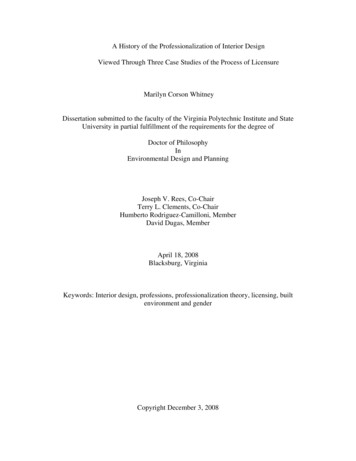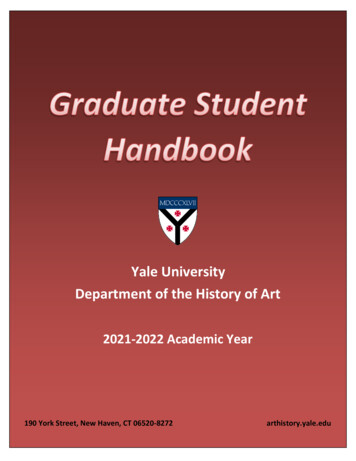
Transcription
A History of the Professionalization of Interior DesignViewed Through Three Case Studies of the Process of LicensureMarilyn Corson WhitneyDissertation submitted to the faculty of the Virginia Polytechnic Institute and StateUniversity in partial fulfillment of the requirements for the degree ofDoctor of PhilosophyInEnvironmental Design and PlanningJoseph V. Rees, Co-ChairTerry L. Clements, Co-ChairHumberto Rodriguez-Camilloni, MemberDavid Dugas, MemberApril 18, 2008Blacksburg, VirginiaKeywords: Interior design, professions, professionalization theory, licensing, builtenvironment and genderCopyright December 3, 2008
A History of the Professionalization of Interior DesignViewed Through Three Case Studies of the Process of LicensureMarilyn Corson WhitneyABSTRACTSince the 1950s, interior decoration evolved into interior design. Throughout the1970s, all of the components for professionalization were in place, but it was not until the1990s that the final transformation made interior design into a profession. Thisdissertation documents these changes and posits that is the conflicts inherent in theprocess of licensure transformed it into a profession.The transformation of interior design is examined through the lens of the theoryof professions, especially Andrew Abbott’s delineation of transformation throughconflict. The historical case studies of the legislative process were of the District ofColumbia, which has practice legislation; the Commonwealth of Virginia; which has titlelegislation; and the State of Ohio, which has no licensing of interior designers as of 2007.Data collection was by interviews with participants of the process of licensure and withthe leadership of the interior design community. In addition, primary and secondarydocuments examined include books, journals, trade magazines, and documents fromprofessional organizations.Specifically, this dissertation addresses these questions: Is interior design aprofession? If so, what forces transformed interior design into a profession? And, how isinterior design different from architecture?This dissertation posits that interior design is unique from architecture because itdeveloped in home economic programs at state universities during the 1950s, 1960s and
A History of the Professionalization of Interior Design1970s. In this locale, the primary focus of interior design was the micro-environmentbased on the theory of behavior. This gives students and practitioners a unique viewpointthat allows for the consideration for each end user as integral to the design process.These attributes contribute to the unique qualities of the services interior design offersand separate it from those of architecture.A simplified definition of interior design that I developed is that interior designutilizes the theory of behavior to design spaces in a micro-environment that function at asafe and efficient level for every end user and are aesthetically pleasing. Finally, interiordesigners need to understand that the strength of their position in the built environment isin the unique services they offers and celebrate their qualities as outlined in thisdocument.iii
A History of the Professionalization of Interior DesignAcknowledgementsThere are so many people to thank that one hardly knows where to begin. Specialthanks to all of the professionals who were interviewed as part of this process. Theirdedication to their professions is documented here. In the order that the interviews tookplace they were: Barbara Goodwin, Brian C. Collins, Jeff Kenney, Kathy Cook, MarkCourtney, Gary Volz, Gayle Kreutzfeld, Terri Maurer, Kayme Dunn, Holly Mattson,Michael Alin, Deanna Waldron, Vincent Carter, Andrea Kelly, Janet Kane, RobertBoynton, Anne Putney Manson, Stacey D’Aquila Hatfield, Eric Weidegreen, CynthiaFaulhaber, Marci Zimmerman, Terry Clements, and Dr. Crystal Weaver.I must also thank my committee for their guidance. Dr. Joseph V. Rees, Terry L.Clements, Dr. Humberto Rodriguez-Camilloni, and Dave Dugas. I would also like tothank Dr. Marilyn Casto who guided me through the proposal process and literaturereview and Chriss Coon for all of her support and help with the myriad of forms requiredin this process. Dr. Jim Jones and Dr. Peter Wallenstein who gave me moral support andinvaluable guidance as my dissertation progressed. My experience at Virginia Tech waslife transforming even before the events of April 16, 2007. A part of my heart willalways reside in the beautiful rolling hills of Virginia.I must thank my transcribers for their hard work of writing out 700 minutes ofinterviews. They include Sreevidya Subramanian, Suzanna Ward, and especially LaurieGood who alone did half of the transcriptions and made this dissertation possible whenwork had come to a standstill for lack of a transcriber.Thank you to my English editors Cynthia B. Faulhaber, and K.C. Arceneaux, andmy content editor Terry Cements and Hannah Mendoza-Torres. I cannot thank Cynthiaiv
A History of the Professionalization of Interior Designand Terry enough for the hours spent shaping and honing my writing into something thatis a semblance of scholarship. Cindy’s exquisite consultation about all aspects of mydissertation refined my thinking and clarified my thoughts, which of course transformedmy writing. Her editing guided me into a more scholarly mode and sometimes evenmade me laugh with her pithy comments. Terry examined the content with a fine-toothcomb to make sure it was reflecting her detailed knowledge of licensing and licensingissues. I could not have done this work without their support and hours of endlessediting.I also would like to thank Mary Agnes G. Carter, who hired me at the age of 25 asan interior designer. She encouraged me to take the NCIDQ exam, join ASID andworked with me on many ASID projects to advance our profession in western Michigan.Her mentorship, support, and encouragement set me on my personal road toprofessionalization.I know that I would not have been successful in completing this document in atimely manner without my study group the Mad CAUS. Our group studied,brainstormed, commiserated, and celebrated together. I owe a large part of my success tothese beautiful, smart, young women. Some of their names have recently changed withDoctor of Philosophy added: Dr. Nancy Cordova, Dr. Sarah Elmasry, Dr. ElizabethGrant, Dr. Tao Huang, Kristin Maki, Dr. Ceylan Oner and the honorary Mad Claves,Katya and Bidou.v
A History of the Professionalization of Interior er 1 – Introduction1Chapter 2 – Literature Review14Section 1 – Introduction14Section 2 – Theory of Professions22Section 3 – History of Interior Design42Section 4 – Professionalization of Architecture54Section 5 – Differentiation of Interior Design and Architecture66Chapter 3 – History of Professionalization of Interior Design73Table 1: Comparison of Google Search about Theory77Chapter 4 – State of the ProfessionSection 1 – Position of Interior Design Professional Organizationson Licensure8989Section 2 – Position of the American Institute of Architectson Interior Design Licensure113Section 3 – Gender Issues128Section 4 – Building Codes137Section 5 – Justification for Licensure146Chapter 5 – Case Studies153Section 1 – Washington, D.C.153Section 2 – The Commonwealth of Virginia180vi
A History of the Professionalization of Interior DesignSection 3 – Ohio196Chapter 6 – Conclusion229Bibliography243Appendix250Appendix A – Interview Waivers250Appendix B – Interview Questions253Appendix C – List of Appellations of Organizations254Appendix D – Timeline History of Interior Design in United States256Appendix E – Archived Documents at ASID – Timeline Washington, D.C.258Appendix F – Archived Documents at ASID – Timeline Virginia270Appendix G – Archived Documents at ASID – Timeline Ohio281Endnotes301vii
Chapter 1 – IntroductionBeginning in the 1950s, interior decoration evolved into interior design and in theprocess of licensure became a profession. Interior designers continued to perform theservices of interior decorators, selecting all of the materials that the building occupantstouch, see, or use. This transformation to interior design expanded the concerns aboutaesthetics to incorporate space planning. This new profession applied psychological andsociological theory to enhance the environment and to modify the behavior of end users,which allowed each end user to function at an optimal and safe level. This documentestablishes the history of the professionalization of interior design and examines efforts toseek licensure in three jurisdictions in the United States 1 using the framework of thetheory of professions.For the purpose of this study, the use of the words “regulation” and “licensing”were generic terms indicating a governmental action. Nonetheless, when discussingindividual jurisdictions2 the use of different terminology in relation to that specificjurisdiction indicates a precise meaning as defined by local laws and regulations. Forexample, when referring to licensing in Virginia, use of the term “certification” denotesthe specific level of regulation related to the scope of work in Virginia.Licensure is a legislative process that establishes minimum criteria for thepractice of a profession in order to protect the health, safety and welfare of the public. Itallows the client who hires a registered professional to know they are hiring someonecapable because of proven education, experience and examination. Licensing is at a stateor jurisdictional level and generally there are two kinds of licensure. The most restrictivetype is a practice act. A practice act prohibits unlicensed individuals from performing the1
A History of the Professionalization of Interior Designduties and activities of a given profession. A title act prohibits an unqualified personfrom calling him or herself a member of the profession. For example, physicians haveboth practice and title legislation – unlicensed persons may neither practice medicine norcall themselves physicians.With the passage of legislation, the steps to obtain a license move to the executivebranch of government. Usually it is in the form of a regulatory board, which sets up rulesand regulation for applicants to become licensed. The steps for procuring a licenseinvolve the following: (1) application by a person wishing to be licensed; (2) provision bythe applicant of proof of sufficient educational background and sometimes experience inthe profession; (3) proof of the successful completion of an examination approved by theregulatory body. The regulatory body reviews the applicant’s documentation and issuesor denies the license. While still in the executive branch, the granting of licenses isseparated from the enforcement and prosecution of violations of the law in order toeliminate conflicts of interest.This dissertation examined case studies of the events associated with the licensingprocess for interior design in three jurisdictions. These jurisdictions were the District ofColumbia, which passed a practice act in 1986, the Commonwealth of Virginia, whichpassed title registration in 1990, and the State of Ohio, which as of 2007 does not regulateinterior design. 3 The research methods included examination of regulatory differencesamong these three regions as determined by interviewing individuals active in the processof regulation in each jurisdiction and by reviewing primary and secondary documentsources.2
A History of the Professionalization of Interior DesignThe theoretical basis of this research is the book, The System of Professions, byAndrew Abbott, which continues the work of others regarding the theory ofprofessionalization. One of Abbott’s key assertions was that conflict, which is inherentin the process of professionalization, creates and shapes a profession into something thatit was not before.4 This study uses this premise to trace changes in interior design inassociation with the efforts for licensing in three jurisdictions. I posit that the conflictinvolved in the professionalization process made interior design into a profession.Specifically, this dissertation will address these questions: Is interior design aprofession? What forces transformed interior design into a profession? How is interiordesign different from architecture?In order to understand the evolution of interior design, it is important tounderstand how the profession currently describes itself. What follows is the officialdefinition of the practice of interior design as stated by the National Council for InteriorDesign Qualification (NCIDQ) retrieved from their web site in 2006:Interior design is a multi-faceted profession in which creative andtechnical solutions are applied within a structure to achieve a builtinterior environment. These solutions are functional, enhance thequality of life and culture of the occupants, and are aestheticallyattractive. Designs are created in response to and coordinated withthe building shell, and acknowledge the physical location and socialcontext of the project. Designs must adhere to code and regulatoryrequirements, and encourage the principles of environmentalsustainability. The interior design process follows a systematic and3
A History of the Professionalization of Interior Designcoordinated methodology, including research, analysis and integrationof knowledge into the creative process, whereby the needs andresources of the client are satisfied to produce an interior space thatfulfills the project goals. 5A simplified definition of interior design is that interior design utilizes the theoryof behavior to design spaces in a micro-environment that are both functional at a safe andefficient level for every end user and are aesthetically pleasing.Although practitioners of interior design have been in evidence in one form oranother for centuries, interior designers first began working on licensing in the 1950s.Olga Guelf stated in her history of the American Society of Interior Design (ASID) thatCalifornia and New York, among other states, were some of the first jurisdictions to worktoward licensing.6The 1970s saw two initial steps toward the professionalization of interior design.They were the establishment of a nationwide examination by the National Council forInterior Design Qualifications (NCIDQ) and accreditation of educational programs by theFoundation for Interior Design Education and Research (FIDER). In the early 1980s,changes to the building codes stopped the ability of interior designers to submitdocuments for building permits. For example in 1981 the alteration section of theBuilding Officials & Code Administrators International, Inc. (BOCA) changed theremodeling clause to require the seal of an architect or professional engineer to submitdocuments for a building permit. This affected interior designers’ right to practice. 7Prior to this change, interior designers had been able to submit documents for projectsthat did not involve a structural component and receive building permits. Afterwards,4
A History of the Professionalization of Interior Designmany interior designers could not submit documents to building departments and had tohire architects or engineers to seal drawings at an additional cost to their clients. Thisaltered code inspired many independent interior designers to work for licensure in theirfield.During the mid-1980s, I believe in response to the changes in the building codethe quest for licensure began in earnest throughout the United States. Part of this processincluded the need to establish that the practice of interior design protected the health,safety, and welfare of the occupants, or there was no basis for licensure.8 The AmericanSociety of Interior Designers’ (ASID) took the position that licensure allowed a client toselect the correct professional for their project by being able to examine qualificationscertified by their governmental jurisdiction. I propose that the challenges inherent inattempting to achieve legislation transformed the profession. This process made interiordesign an independent profession in its own right.Allen Tate and C. Ray Smith stated in Interior Design in the 20th Century thatinterior design is grounded in behavioral theory. 9 An interior designer’s primary concernis for the occupant of the space; the focus is on the individual and his/her need to functionat an optimal level in the designed environment. Thus, the general concerns inherent ininterior design include a commitment to develop an interior environment that reflectsclient’s needs and behaviors, as well as aesthetic concerns.Interior design is a profession whose practitioners consist of many more womenthan men. In fact in 2004, the ASID’s statistics reports 80% of their membership werewomen.10 This feminization had its historical roots the fact that many interior designprograms developed in home economic departments, which were the almost exclusive5
A History of the Professionalization of Interior Designdomain of women. I posit that although the training is not exclusive of male students thevalues taught and internalized by the students are imbued with feminized connotation bythe programs’ previous academic location in home economics. By the 1970s, when manyhome economic programs changed their names to reflect the scientific nature of the fieldthe theoretical basis of the field had already been established. Over the years, thesevalues have cross-pollinated with other programs located in schools of art andarchitecture through scholarly publications and presentations at the Interior DesignEducators Council (IDEC) conferences.Feminist theory encourages us to define feminine professions by establishingwhat they are rather than what they are not. Thus, this research will also discuss what thefemale point of view brings to the profession of interior design that helps define it asdistinctly feminine. Indeed, I argue that the feminization of the profession gives interiordesign innate and highly desirable feminine traits that are indispensable to and indivisiblefrom the practice of the profession. 11 These traits differentiate interior design from otherprofessions by humanizing the built environment. They are an integral part of thebuilding team offering a specialized viewpoint and unique service.In addition to a discussion of the feminization of the profession, this study alsoincludes an examination of the forces that led to the development of interior design as anindependent profession, beginning with the rapid expansion of projects in response to thebuilding boom after World War II. Tracts of new homes arose during this period ofunparalleled growth of suburban development. These new developments had a few basicmodels, which then needed to be personalized by their owners. Interior designers helpedpersonalize these houses. The growth in commercial interior design was even more6
A History of the Professionalization of Interior Designexplosive with projects ranging universities to hospitals, restaurants to hotels, and retailspaces to office spaces. This building explosion produced a need for a new service – thedesign of the interior. These developments, coupled with an expanding educationalsystem and women flooding into universities in the 1960s and 1970s, helped fill the needfor university educated interior designers. By 1985, ASID estimated that there were200,000 people in the United States working in interior design firms (ASID White Paper,1987).By the l980s, architecture firms realized the potential of this new market andbegan to hire interior designers on staff, add interior design to their list of services, andbill for those services as a separate expenditure from the design of the building.12 Otherchanges also affected this budding profession. In 1981, changes to the building codecompelled building officials around the country to require an architectural or professionalengineering seal on drawings submitted for permits, even those submitted for remodelingof existing buildings. By 1985, ASID and the Institute of Business Designers (IBD) werehelping local chapters organize to work on licensing in their jurisdictions. Thisdissertation traces the process toward licensure in three of those jurisdictions:Washington, D.C., Virginia, and Ohio.Importance of the StudyThis historical study documents the process of professionalization of interiordesign using the lens of licensure. This is the first time that the history of theprofessionalization of the field has been complied and analyzed. There are criticalimplications to be derived from this study that are important to the profession as it movesinto the 21st Century. In this dissertation, I argue for the continued effort toward the7
A History of the Professionalization of Interior Designpassage of new licensing and the tightening of existing laws. My research demonstratesthat licensing is critical to protecting the independent practice of interior design. Inaddition, it proves that between 1985 and 2007, interior design became a profession bystrengthening its definition and successfully differentiating itself from other professions.This study provides interior design scholars and students with information on howinterior design became a profession and describes the unique services it offers. Interiordesigners and others professionals working on the licensure process can use this study tounderstand the process of legislation, the issues involved, and the pressures inherent inthe process. It is designed to help them better understand that the inevitable conflict ispart of this process, thereby giving them the necessary preparation to face the conflictwhile pursuing licensure. In addition, by documenting these efforts, practicing interiordesigners can learn about the critical nature of the efforts made on their behalf by otherinterior designers to legitimize interior design as an independent and regulatedprofession. I hope this induces them to become licensed in their own states orjurisdictions. As Vincent G. Carter, of Washington, D.C., said in his interview the effortsfor more strict legislation are impeded when few practitioners become certified under titlelegislation. 13Research MethodsThe research examines the specific events that led to the licensing and/orregulation of the profession of interior design in three jurisdictions. In 2007, thesejurisdictions had different levels of regulation: Washington, D.C. had a practice act,Virginia had a title act, and Ohio had no licensing. I choose to compare these threejurisdictions because of the variation in their levels of regulation, the length of time they8
A History of the Professionalization of Interior Designhad been working on legislation, and their location in close proximity to VirginiaPolytechnic Institute and State University.14The research methods utilized were historical case-study, including first-personinterviews with interior designers active in the process of achieving licensing for theirindividual jurisdictions and with the leaders of several of the professional organizations.The interviews were done from 2005 through 2007. These interviews concerned eventsthat occurred fifteen to twenty years before the interviews. Inevitably, the passage oftime limits the accuracy of an individual’s recollections because of personalinterpretation of events. This research ameliorated this limitation by conducting threeinterviews for each jurisdiction to help confirm events. Despite that attempt, revisionistthinking by the group may have affected the accuracy of the information. Therefore, myresearch included the review of primary and secondary documentation archived at ASIDNational headquarters and generated at the time of the events. This allowed fortriangulation to confirm the information collected through the first-person interviews.The interviews with the leadership helped to establish the state of the profession as of2007.The selection of interviewees was accomplished by contacting ASID chapters ineach jurisdiction. For example, in Virginia, I attended an ASID meeting in Richmondand asked for the names of people who were active in the process. In Washington, D.C.and Ohio, an individual at the local chapter who answered an e-mail inquiry directed meto people they knew to be active in the process. Primary documents from ASID Nationalconfirmed the relevancy of these contacts, as these people were presidents of the coalitionand their names appeared repeatedly on documentation collected by ASID over the years.9
A History of the Professionalization of Interior DesignIn Washington, D.C., two of the participants active in the process did not return repeatedtelephone calls, so a third interview could not be completed. 15 In addition, attempts tointerview the architects who had primary knowledge of the licensure process in the threejurisdictions failed to produce interviews in Washington, D.C., and Ohio. The actors inthe process did not return repeated e-mails or telephone calls. One architect fromVirginia responded and because he was active on the national as well as the state level,his interview represented both the American Institute of Architects (AIA) and AIAVirginia viewpoints on licensing issues for interior design during the this period of time.The primary documentation used in this study came from the files archived atASID Headquarters in Washington, D.C. They were collected in 2005. Thesedocuments included memorandums, faxes, hand-written notes about telephoneconversation, letters, testimony and emails from the participants in the effort for oragainst licensure. There were also documents from the coalitions, professionalorganizations and governmental bodies including draft and final copies of legislation,rules and regulations, newsletters, surveys and other documents with no specific author.Volunteers who worked in each jurisdiction sent these documents to ASID. However, aswith any voluntary activity of busy people, they did not always forward all of thematerial. Although the documents captured different periods-of-time when criticalactivity occurred, they may have afforded a less than perfect record of events. Thepertinent text of these documents is included in Appendices H, I and J. These documentsreflect the high and low points in the process of licensing and the maintenance of the acts.This study also relied on secondary sources contemporary to the process includingbooks, trade magazines, scholarly journals, and documents prepared by ASID, IBD,10
A History of the Professionalization of Interior DesignInternational Interior Design Association (IIDA), and the American Institute ofArchitects (AIA). Most of the literature review was complete by 2005. The otherliterature included examination of newsletters and handouts from other relevantprofessional organizations operating at both the local and national levels.Limitations of the Research MethodsIn addition to the limitations discussed above, the scope of this project waslimited to three jurisdictions active in the legislative process from 1985 through 2007.This period of time is particularly important because it represents an era when 70% ofinterior designers practicing in the United States lived in a jurisdiction that allowed themto become licensed. The jurisdictions with licensing include: Alabama, Arkansas,California, Colorado, Connecticut, Florida, Georgia, Illinois, Kentucky, Louisiana,Maine, Maryland, Minnesota, New Jersey, New Mexico, New York, Okalahoma, PuertoRico, Tennessee, Texas, Virginia, Washington, D.C. and Wisconsin.Additionally, personal bias must be considered as I am an interior design educatorwho practiced interior design for twenty-five years and was a member of a statewidelegislative coalition supporting licensure in Michigan from 1990 to 2003. I served aspresident of the Coalition for Interior Design Registration (CIDR) for four years duringtwo unsuccessful attempts to achieve licensing in Michigan.16 The choice of the threejurisdictions and the historical nature of the study attempts to mitigate the bias of theresearcher. I engaged in a critical reflective approach that created an awareness of mybias that allowed me to be conscious of its operations. 1711
A History of the Professionalization of Interior DesignContinuing ResearchThis research represents a comprehensive history of the professionalization ofinterior design until the end of 2007. It is a beginning to the study of the licensureprocess for interior designers. Other professions working on licensure can learn from thisinformation. Continued work is needed to document the process toward licensure inother jurisdictions. Other research will help to understand the opinion of rank and fileinterior designers regarding the effects of licensing on practice and other issues related tothe professionalization of interior design.Organization of the DissertationThe organization of this dissertation establishes the history of theprofessionalization of interior design through the lens of licensure to compare andanalyze the information in the study. This introductory chapter outlines the problem,methods, bias, and some of the results. Chapter 2, the literature review, has five sections.Each section focuses on a different part of the history of interior design. The histories ofthe professions of interior design and architecture are critical to understanding the eventsdescribed in the research component of this document. The last section compares theaccreditation, examination, internship and theory base of interior design and architecture.These establish background and context for the information gleaned from the interviews.Chapter 3 establishes a history of the professionalization of interior design. The Chapter 4consists of five sections, which examine the position of the main players, includinginterviews with the leaders of professional organizations. I
documents examined include books, journals, trade magazines, and documents from professional organizations. Specifically, this dissertation addresses these questions: Is interior design a profession? If so, what forces transformed interior design into a profession? . Interior design










